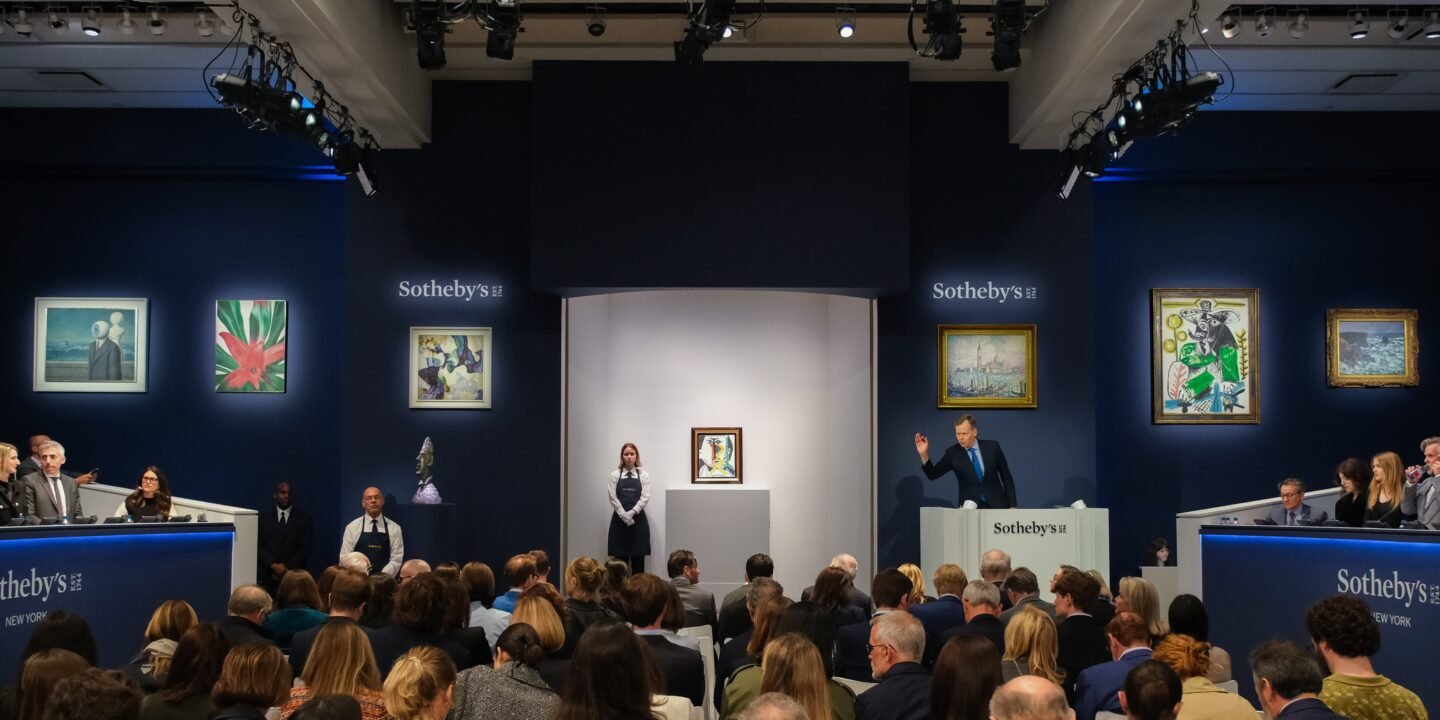

The subdued and measured performances in New York’s marquee week sales this past May, followed by tepid results in June’s auctions in London—which saw combined revenue across houses down 26 percent, from £132 million in 2024 to just £98 million in 2025—have confirmed yet again that auction houses must now operate with surgical precision and risk-averse rigor, carefully choreographing sales through tightly calibrated estimates and an ever-growing reliance on guarantees.
According to Art Basel and UBS’s annual report, public auction values fell 20 percent year over year, with the high-end segment suffering one of the steepest declines on record. In this climate, houses are compelled to play it safe in both their offerings and the architecture of each sale to deliver acceptable results. But with owners increasingly reluctant to sell in such a volatile market, houses are forced to compete for prestigious consignments and masterpieces by offering guarantees. These guarantees are typically underwritten by third parties or, if necessary, covered internally. The aim is to ensure there’s at least one bid “in the book” to ignite competition during the sale, while simultaneously reducing financial risk on both ends.
The arrangement takes the form of a third-party guarantee, or more discreetly, an “irrevocable bid”—a financial commitment in which a buyer agrees in advance to purchase a lot for a specific amount if no higher bid materializes during the auction. Though the two terms are often used interchangeably, there are subtle distinctions in meaning depending on the house. Christie’s generally prefers the umbrella term “third-party guarantee,” while Sotheby’s tends to favor “irrevocable bid,” highlighting that the external party has committed to publicly and irrevocably bidding in advance rather than relying on an internal guarantee. For the house, it’s a riskless safeguard. For the guarantor, it’s a calculated wager, albeit one dressed in velvet gloves.
In today’s challenging market, third-party guarantees have become essential not only in the marquee Evening Sales but also, increasingly, in the Day Sales. What was once a public marketplace has become a pre-scripted performance, its outcomes often negotiated in advance. The choreography only breaks when a bidder dares to veer off-script or when a consignor boldly chooses to face the market “naked,” declining such protections. That was the case with the Alberto Giacometti bust of his brother Diego at Sotheby’s in May, which spectacularly flamed out after a $70 million estimate, failing to find a buyer in the “real market” at that price.
“From zero to almost everything,” wrote Pi-eX Ltd CEO Christine Bourron on LinkedIn following the May Sales, in a post accompanied by data her firm compiled from the auctions recently concluded. In only four years, she noted, third-party guarantees have gone from virtually nonexistent to nearly ubiquitous across single-owner collections offered in May sales, pointing to a chart tracking guarantee use from 2021 to 2025. In 2021, major collections like the John Marion Collection at Sotheby’s and the Ammann Collection at Christie’s entered the market without a financial safety net. By contrast, May 2025’s standout evening sale, the “Leonard & Louise Riggio: Collected Works,” was 99 percent backed by third-party guarantees across its hammer total, ultimately closing with $489 million in sales.


According to Pi-eX’s analysis, third-party guarantee coverage reached a record high of 73 percent during the Modern and Contemporary evening sales in New York this past May. Christie’s led the field, with 83 percent of its hammer total secured by irrevocable bids, while Sotheby’s and Phillips followed at 63 percent and 65 percent, respectively.
As outlined in an article published by Overstone Art Services earlier this year, the Impressionist and Modern category (1860-1945) experienced the most significant rise in third-party guarantees, with a 43 percent year-over-year increase. Post-War works (1946-1970) followed with a modest 5 percent gain, while the Contemporary segment (1971-2000) saw the sharpest decline, down 36 percent. Post-2000 works registered a slight 3 percent dip. The analysis suggests that this retreat in guarantees for the so-called “wet paint” segments—Contemporary and Post-2000—reflects a broader cooling of demand in artist markets that, until recently, seemed unstoppable.
Overstone’s breakdown by location reveals a similar shift. Hong Kong recorded growth, while both London and New York experienced declines. The number of guaranteed lots in Hong Kong doubled year-on-year—from 7 to 14—alongside a rise in average low estimates. In contrast, New York saw a 10 percent drop, with guaranteed lots falling from 134 to 121. The report attributes Hong Kong’s uptick to auction houses’ intensified investment in the region, seeking strong results and using guarantees to enhance visibility and market confidence. But the results told a different story: Modern and Contemporary art sales at Sotheby’s, Christie’s, and Phillips in Hong Kong during Spring 2025 totaled just HKD 1.3 billion ($165 million), a 39 percent drop from Spring 2024’s HKD 2.1 billion ($269 million). That followed a 33 percent decline the year before, according to Pi-eX’s analysis, suggesting that despite strategic guarantees, momentum continues to slip.


But beyond the numbers, another shift is stirring debate: as the landscape grows increasingly challenging for auction houses across regions, guarantees are no longer confined to Evening Sales. Once a discreet financial tool used to reassure consignors—particularly for high-profile lots featured in the spectacle of the marquee auctions—their role has expanded significantly and is now increasingly shaping the dynamics of the Day Sales as well.
Additional Pi-eX data shared a few weeks later by Bourron on LinkedIn and has since sparked a lively exchange with French collector Sylvain Levy, who reposted the analysis with his own commentary. Christie’s chairman Guillaume Cerutti followed with a response of his own, posted just days ago.
While Day Sales have historically remained largely guarantee-free—serving as a more transparent and unfiltered testing ground for the market—Pi-eX’s analysis shows that in May, third-party guarantees accounted for at least 20 percent of the total hammer price. Sotheby’s leaned most heavily on the mechanism, with 28 percent of its Day Sale covered by such agreements, followed by Christie’s at 12 percent and Phillips at 9 percent.
According to Bourron, this marks a deeper structural shift in how risk, value and confidence are managed across the auction ecosystem. What was once a tool reserved for top-tier lots has now become part of the standard, risk-averse machinery of the day-to-day auction business.
As Levy notes in his commentary, this framework, while boosting consignor confidence and encouraging the circulation of high-value works in the face of volatility and global instability, also risks irreparably blurring the line between true market demand and pre-negotiated choreography. The result is a marketplace that feels increasingly staged and financialized, making it harder than ever to discern where real demand lies across price points and categories.


“As third-party guarantees extend their influence beyond evening spectacles into the fabric of the day-to-day market, they are quietly transforming the art world’s risk–reward equation,” Levy pointedly writes. “In this new environment, informed engagement with these mechanisms is not merely advisable—it is essential.”
“Guarantees are primarily used for high-value works or collections offered in evening sales. The growing use of this mechanism in Day Sales for lower-value works is a fact,” Cerutti asserts. He recently stepped down as Christie’s CEO to become president of the Pinault Collection but continues to serve as Chairman of Christie’s Board.
While acknowledging the increasing use of guarantees in the day-to-day business of auctions, Cerutti suggests that some of the trend may be attributed to global guarantees applied across entire collections, with works dispersed between Evening and Day Sales. “It would be interesting to track the proportion of lots in Day Sales that come with a guarantee, outside the context of a broader collection,” he proposes.
In his response to Pi-eX’s analysis, Cerutti characterizes guarantees as a hybrid structure—one that fuses the respective advantages of private sales and auctions. He attributes their growing prevalence to the rise of active art advisers—many of them former auction house specialists—who now broker terms on behalf of clients and, in doing so, intensify competition between houses ahead of each sale to secure optimal financial arrangements.
Cerutti concedes that one consequence of this growing reliance on third-party guarantees is that a substantial portion of auctions is now effectively settled in advance, de-risking consignments and stabilizing outcomes, but at the cost of suspense. The adrenaline once tied to the unpredictability of a straight consignment has been displaced by the measured calm of a choreographed performance. And while he admits that “the excitement in the room is no longer what it once was,” for Cerutti, this is simply the price of keeping the art market in motion during a subdued moment. Confidence must stay high, and the show, as ever, must go on.









